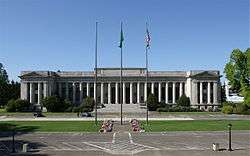Washington Supreme Court
The Washington Supreme Court is the highest court in the judiciary of the US state of Washington. The Court is composed of a Chief Justice and eight Justices. Members of the Court are elected to six-year terms. Justices must retire at the end of the calendar year in which they reach the age of 75, per the Washington State Constitution.[1]
| Washington Supreme Court | |
|---|---|
 | |
| Established | November 9, 1889 |
| Location | Olympia, Washington |
| Composition method | Election |
| Authorized by | Washington State Constitution |
| Appeals to | Supreme Court of the United States |
| Judge term length | 6 years |
| Number of positions | 9 |
| Website | Official website |
| Chief Justice | |
| Currently | Debra L. Stephens |
| Since | January 5, 2020 |
| Jurist term ends | 2040 |
The Chief Justice is chosen by secret ballot by the Justices to serve a 4-year term. The current Chief Justice is Debra L. Stephens who was elected by her peers on November 6, 2019. Chief Justice Debra Stephens was sworn in on January 5, 2020, and succeeds Mary Fairhurst, who retired for medical reasons.
Prior to January 1997 (pursuant to a Constitutional amendment adopted in 1995) the post of Chief Justice was held for a 2-year term by a justice who (i) was one of the Justices with 2 years left in their term, (ii) was the most senior in years of service of that cohort, and (iii) (generally) had not previously served as Chief Justice. The last Chief Justice under the rotation system, Barbara Durham was the architect of the present internal election system, and was the first to be elected under the new procedure, serving until her resignation in 1999.
The court convenes in the Temple of Justice, a historic building on the Washington State Capitol campus in Olympia, Washington.
The persuasiveness of the Court's decisions reaches far beyond Washington's borders. A Supreme Court of California study published in 2007 found that the Washington Supreme Court's decisions were the second most widely followed by the appellate courts of all other US states in the period from 1940 to 2005 (second only to California).[2]
Selection
Members of the Court are elected to six-year terms, with three justices elected in each even-numbered year in a nonpartisan election with a top-two primary. Judicial elections in Washington, including for the Supreme Court, are frequently uncontested and incumbents typically win reelection.[3] The last time a justice lost reelection was in 2010 when Charlies Wiggins defeated Richard B. Sanders,[4] who had previously defeated Rosselle Pekelis in 1995.[5] When Chief Justice Keith M. Callow lost to Charles W. Johnson in 1990, it was the first time in 40 years an incumbent had lost.[6]
The only required qualification for justices is that they are admitted to practice law in Washington.[7]
In case of a vacancy, the Governor of Washington may appoint a replacement who must stand in the next election to fill the unexpired term.[7] Five of the current nine judges were originally appointed.
Current justices
| Seat # | Title | Name | Joined the Court | Current term ends | Age 75 | Appointed by | Legal education |
|---|---|---|---|---|---|---|---|
| 7 | Chief Justice | Debra L. Stephens | January 1, 2008 | January 10, 2021 | 2040 | Christine Gregoire | Gonzaga University School of Law |
| 4 | Associate Chief Justice | Charles W. Johnson | January 1991 | January 10, 2021 | 2026 | – | Seattle University School of Law |
| 5 | Justice | Barbara Madsen | January 1993 | January 8, 2023 | 2027 | – | Gonzaga University School of Law |
| 2 | Justice | Susan Owens | January 1, 2001 | January 12, 2025 | 2025 | – | University of North Carolina School of Law |
| 8 | Justice | Steven Gonzalez | January 1, 2012 | January 12, 2025 | 2038 | Christine Gregoire | University of California, Berkeley School of Law |
| 9 | Justice | Sheryl Gordon McCloud | January 1, 2013 | January 12, 2025 | 2030 | – | USC Gould School of Law |
| 1 | Justice | Mary Yu | May 20, 2014 | January 8, 2023 | 2032 | Jay Inslee | Notre Dame Law School |
| 3 | Justice | Raquel Montoya-Lewis | January 5, 2020 | January 10, 2021 | 2043 | Jay Inslee | University of Washington School of Law |
| 6 | Justice | G. Helen Whitener | April 13, 2020 | January 10, 2021 | 2040 | Jay Inslee | Seattle University School of Law |
History
The early history of the Washington Supreme Court has been described as follows:
The constitution fixed the terms of supreme court judges at six years, and provided that the first judges should determine by lot, two to serve for three years, two for five years, and one for seven years. This was to prevent a too sweeping change of the court at any one time. The judge with the shortest term to serve is elected by the court as chief justice, which allows most of the judges to enjoy that honor in turn. Judge Dunbar is the only one who has served continuously through the life of this court. There are a few irregularities in the length of the terms. Judge Gordon resigned in June, 1900. Governor Rogers appointed William H. White to take his place. In November of the same year Judge White was regularly elected, but the term ended the following January. The Legislature in 1901 provided for the appointment of two judges to serve only until October, 1902. Governor Rogers appointed to these positions William H. White and Hiram E. Hadley. In 1905, the Legislature permanently increased the court from five to seven. Governor Mead appointed Herman D. Crow and Milo A. Root. At the next election, in 1906, those two judges were regularly elected for the terms expiring in 1909. After his election in November, 1908, Judge Root resigned.[8]
Candidates for election were originally nominated at party conventions, but in 1907 it became a direct nonpartisan election.[9]
Carolyn R. Dimmick was the first woman to sit on the court, taking her seat in 1981. Barbara Durham was the first female chief justice, selected in 1995. Charles Z. Smith, appointed 1988, was the first African American to serve on the court. Mary Yu became the first LGBT, Asian American, and Latina member in 2014.[10] A majority of justices has been female since 2013. After the appointment of Helen Whitener in 2020, the court was called "arguably the most diverse court, state or federal, in American history",[11] with various incumbents reflecting the state's white, black, Hispanic, Asian American, Native American, LGBT, immigrant, Jewish, and disabled populations.
Notable cases
- McCleary v. Washington (2012) – The state of Washington failed to meet its Constitutional duty to adequately fund education.
- State v. Gregory (2018) – Unanimously decided the death penalty in Washington violated the state constitution, as applied[12][13]
Gallery
 The court meets in the Temple of Justice in Olympia
The court meets in the Temple of Justice in Olympia The interior of the Washington State Supreme Court
The interior of the Washington State Supreme Court Inside the Law Library
Inside the Law Library The foyer of the Temple of Justice building
The foyer of the Temple of Justice building
References
- "Washington State Constitution, Article IV § 3(a)".
- Dear, Jake; Jessen, Edward W (2007). "'Followed Rates' and Leading State Cases, 1940–2005" (PDF). U.C. Davis Law Review. 41: 683–694.
- Cohen, Josh. "Most of WA's judges are running unopposed. Does it matter?". crosscut.com. Retrieved December 13, 2019.
- Sanders, Eli (November 10, 2010). "How Justice Richard B. Sanders Lost It". The Stranger. Retrieved December 13, 2019.
- "Supreme Court justice is ousted". Lewiston Morning Tribune. Retrieved December 13, 2019.
- London, Robb; Times, Special To the New York (September 28, 1990). "LAW; For Want of Recognition, Chief Justice Is Ousted". The New York Times. ISSN 0362-4331. Retrieved December 13, 2019.
- "Washington State Courts - Supreme Court". www.courts.wa.gov. Retrieved December 13, 2019.
- Edmond Stephen Meany, History of the State of Washington (1909), p. 366.
- "Brief History of the Washington State Supreme Court". Washington State Courts. Retrieved April 23, 2020.
- La Corte, Rachel (May 1, 2014). "Mary Yu appointed to state Supreme Court". The Seattle Times. Retrieved December 13, 2019.
- Stern, Mark Joseph (April 17, 2020). "Washington State Now Has the Most Diverse Supreme Court In History". Slate Magazine. Retrieved April 23, 2020.
- Note, Recent Case: Washington State Supreme Court Declares Death Penalty Unconstitutional In Washington, 132 Harv. L. Rev. 1764 (2019).
- State v. Gregory, 427 P.3d 621 (Wash. 2018).
External links
- Washington State Supreme Court at Ballotpedia
- Archives: Walter B. Beals papers. circa 1400-1951. 66.00 cubic feet. At University of Washington Libraries, Special Collections.